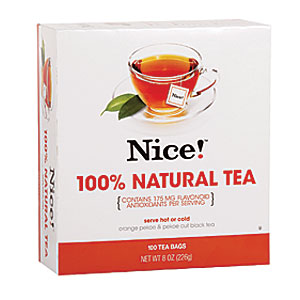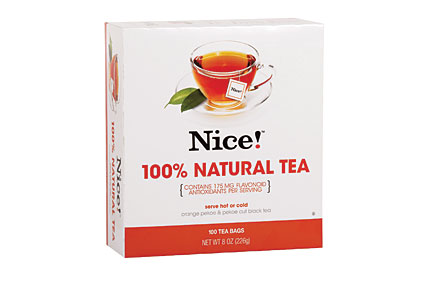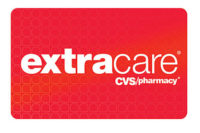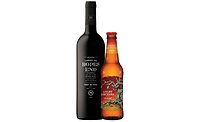
|
| Walgreens launched its Nice! store brand line of food, beverage and household items last summer. The line is part of Walgreens’ strategy to build its private brand business, including consolidation of many of the brands in its existing portfolio. |
The drug store channel showed higher-than-average growth last year with unit sales increasing 2.2 percent versus a retail industry average decline of 0.6 percent in food, drug, convenience and mass merchandise stores, excluding Walmart, according to Susan Viamari, consumer insights expert at Chicago-based SymphonyIRI Group. The National Association of Chain Drug Stores (NACDS), Alexandria, Va., adds that drug store sales were up 3.4 percent through November 2011 compared to the same time period in 2010.
This growth is significantly less than the 7.7 percent increase reported for overall retail sales, NACDS adds. Nevertheless, beverage unit sales grew 8 percent in the drug store channel versus an industry average of 2 percent, SymphonyIRI’s Viamari says.
“Drug stores are benefiting from an escalation in quick-trip behavior,” Viamari says. “Drug retailers, already an established destination for health and beauty-related purchases, are stepping up their game in an effort to capitalize on increased trips by offering more breadth and depth in their food and beverage assortments.”
In 2011, nearly two-thirds of beverage categories grew in unit sales within the drug store channel, and 35 percent of beverage categories saw double-digit growth, she says. The strongest beverage category in the drug store channel last year was shelf-stable canned juices, which increased almost 37 percent in unit sales. Likewise, multiple beverage categories saw increases in dollar sales, including wine, which grew 17.2 percent; carbonated beverages, which increased 10.7 percent; beer, ale and hard cider, which grew 7.1 percent; bottled water, which increased 3.7 percent; and spirits and liquor, which grew 2.4 percent, Viamari says.
NACDS, however, noted increases in all beverage categories except carbonated beverages, with wine showing the highest growth.
Drug store demographics
Beverages aren’t the only things competing for share in the drug store channel. Retailers also are competing for particular demographics. Generally speaking, men are more drawn to convenience stores, and women visit drug stores more often, says Virginia Lee, senior research analyst at Euromonitor International, Chicago.
“In general, women are the guardians of the family’s health, so they’re already in [drug stores] picking up a prescription and over-the-counter medicine, and now they can pick up a soda, energy drink or bottled juice,” she explains.
Presenting another opportunity to bring in female shoppers, major drug store chains Walgreens, Deerfield, Ill., and CVS Caremark, Woonsocket, R.I., expanded their food and beverage selections and upgraded the appearance of their beauty departments, Lee says. About two years ago, Walgreens introduced its customer-centric retailing store format, which lowered the heights of shelves; increased signage for better navigation; expanded food, wine and beauty aisle offerings; and decreased the number of SKUs to focus more on best-sellers.
The introduction of walk-in health clinics also has aided in growing drug store traffic, says Jon Hauptman, partner at Willard Bishop LLC, Barrington, Ill.
“Drug stores have done a better job than almost any other fast-moving consumer goods retail channel of reinventing themselves to attract shoppers,” he says. “A few years ago, drug stores adjusted their positioning to attract convenience store shoppers — particularly females. Now, they are enhancing their offerings to serve as a destination for all health-related needs — seen by the inclusion of walk-in health clinics in many locations — as well as becoming an agreeable alternative to the supermarket by offering a wide range of grocery products including perishables and immediately consumable meals at some stores.”
An aging baby boomer population also will aid in more visits to drug stores’ walk-in clinics and pharmacies, says Euromonitor’s research associate Kailing Cai.
In turn, drug store doctors and pharmacists also can benefit retailers. Euromonitor’s Cai and NACDS both note that these healthcare professionals could help shoppers with over-the-counter medications as well as health and wellness beverage choices in drug stores.
With nearly all Americans living within 5 miles of a community pharmacy, getting access to these professionals is not hard to do, NACDS says. Convenient store locations make drug retailers an ideal place for consumers to fulfill their beverage needs, it adds.
“Many community drug stores are harnessing their highly accessible locations to tailor their services to local populations, whether through premium cafés, beer selections or juice bars,” NACDS says. “Chains use these consumer-focused innovations to see what works in what setting to enhance the local shopping experience.”
Walgreens subsidiary Duane Reade opened its flagship store in Manhattan’s financial district last summer, featuring an in-store Starbucks, juice bar, sushi bar, prepared foods to go, nail bar, hair salon, pharmacy and walk-in clinic. The Duane Reade store also enlists a cell phone charging station for convenience and a holograph/audio-visual technology virtual greeter for navigation help. The store won a design award earlier this year in the Convenience Store/Pharmacy category at the Retail Design Institute’s 41st annual international awards program.
Walgreens also recently opened a two-story flagship location in Chicago that features an upscale café offering fresh-brewed premium coffee, a juice bar and soda fountain, a Coca-Cola Freestyle machine, a fine wine selection made up of more than 700 wines, a nail bar, a beauty department staffed with trained beauty advisers, a state-of-the-art pharmacy, an immediate care clinic and hundreds of fresh food items.
“This unique urban retailing concept raises the bar for drug store retailing and sets us apart in our industry,” said Joe Magnacca, president of daily living products and solutions for Walgreens, in a statement. “As we transform from a traditional drug store to a retail health and daily living destination, this store demonstrates how we are a central part of life for many who live and work in this dynamic and thriving community.”
Stretching a dollar
Although drug stores are working to offer convenient locations and layouts for shoppers, they mustn’t forget about value, SymphonyIRI’s Viamari says. One-quarter of shoppers have difficulty affording their weekly groceries, according to SymphonyIRI’s MarketPulse survey. To try to stretch their dollars, 52 percent of shoppers choose where to shop based on which store has the lowest prices on needed items, and 40 percent shop multiple stores to find the lowest prices for all of the items on their lists.
“Drug retailers are competing, not just with grocers, but value channel retailers for a share of beverage spending,” Viamari says. “To win share, drug retailers must partner with manufacturers to carefully set their everyday beverage prices to optimize price gap thresholds between competitive brands, taking into consideration the local competitive environment.”
In addition to offering reasonable prices on branded products, drug stores are turning to private label as a valuable option. Shoppers are continually searching for inexpensive products across all retail formats, says Willard Bishop’s Hauptman, and many have turned to private label offerings as a solution.
“Demand for private label has increased in all channels and drug stores are beginning to take significant steps to enhance their private label offerings to respond to shopper needs and differentiate from retail competition,” he says. “A great example is all the steps that Walgreens has taken over the past year to revitalize their private label offerings, including consolidating some private brands and launching new private brands in an effort to double private label sales over the next five to seven years.”
According to SymphonyIRI’s MarketPulse survey, 50 percent of consumers buy more private label products today than they did before the economic downturn. Within the drug store channel, private label accounts for 15 percent of dollar sales and 14.5 percent of unit sales, SymphonyIRI’s Viamari reports. The channel lost one dollar share point and nearly two unit share points for private label in 2011; however, private label dollar and unit shares increased within grocery, supercenters, mass merchandisers and club stores, she says.
Loyalty card programs also can help shoppers save on drug store purchases and increase traffic in a down economy, analysts say. CVS/pharmacy’s ExtraCare Rewards Program pays customers back 2 percent on purchases in the form of a coupon printed at the bottom of the store receipt. It also rewards customers with $1 to spend on front-of-store merchandise for every two prescriptions purchased, according to the retailer.
Walgreens plans to relaunch its loyalty program this year, Willard Bishop’s Hauptman says.
Another incentive to keep shoppers coming back is leveraging the power of shopper data to develop targeted offers and rewards, Willard Bishop’s Hauptman says. “The advantage that drug stores have is that they’re somewhat later to shopper-centered marketing and merchandising than other channels such as supermarkets, which gives them the ability to learn from others and possibly ‘leap frog’ them with next-generation capabilities and offers,” he explains.
Challenges and opportunities
With expanding possibilities, drug stores still are generally challenged by retail space constraints as opposed to larger retail segments, Euromonitor’s Cai says. If retailers want to increase a store’s beverage portfolio, for example, it has to balance its product mix to cater to its consumer base without overburdening its retail space, she adds.
Although drug stores are implementing innovative merchandising initiatives and easy-to-navigate layouts, larger retailers might threaten their shopper base.
“Retailers like Target and Walmart have figured out that there is money to be made in urban markets and they’re introducing slightly smaller formats that are slightly easier to get zoning approval and good real estate, like Walmart with the Neighborhood Market in the [Chicago] loop,” Euromonitor’s Lee says.
The prices at these urban markets likely will be lower than those at drug stores, such as CVS and Walgreens, she says. However, that might not necessarily be a problem for drug stores. Willard Bishop’s Hauptman says: “While beverage growth in other non-traditional retail food formats, such as supercenters, dollar stores and limited-assortment stores, has been based on delivering low prices, beverage growth in the ‘new’ drug store can be focused on offering unique variety and options, whether it’s to take home or for immediate consumption, while delivering competitive prices through unique tactics such as target offers, etc. Drug stores will not have to be the knock-down, drag-out low price leader to grow beverage category sales.” BI




